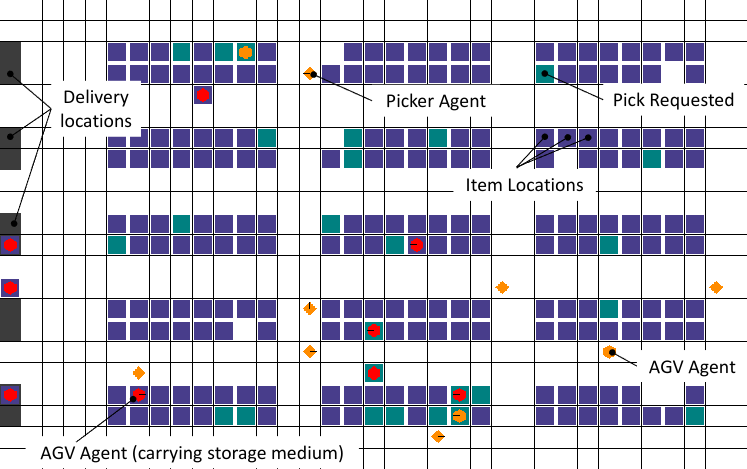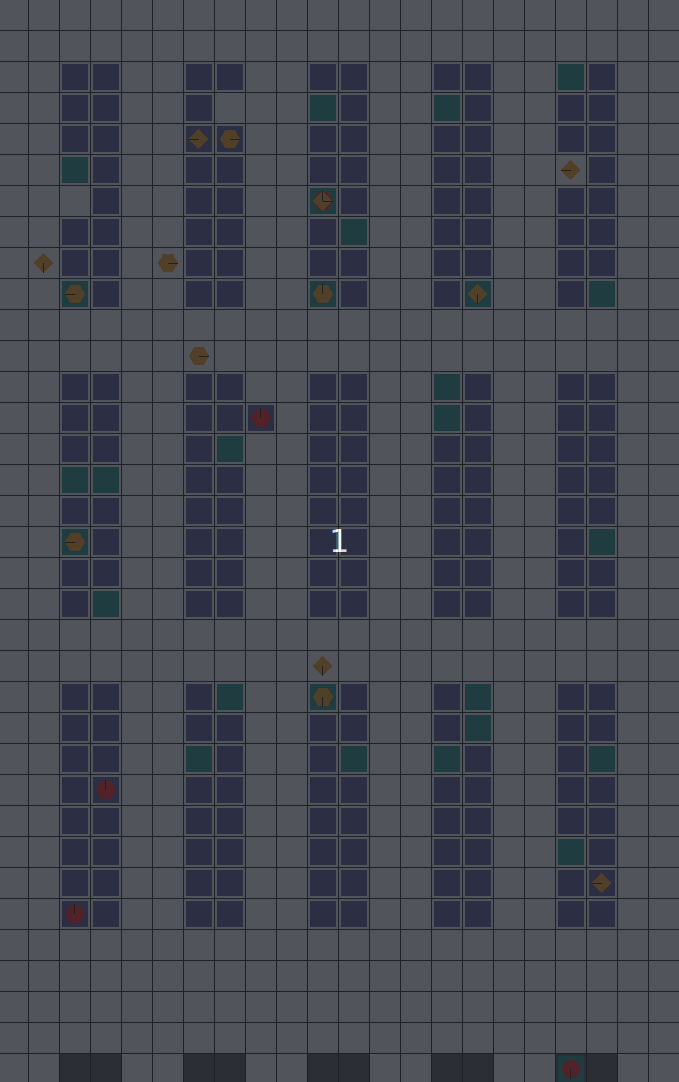TA-RWARE: Task-Assignment Multi-Robot Warehouse
The task-assignment multi-robot warehouse (TA-RWARE) is an adaptation of the original multi-robot warehouse (RWARE) environment to enable a more realistic scenario where two groups of heterogenous agents are required to cooperate to execute a pick and the actions of each agent represent locations in the warehouse to facilitate this cooperation and direct optimization of pick-rate, measured in order-lines per hour. We denote one group of these agents as AGVs (carrier agents) and Pickers (loading agents).
The environment is configurable: it allows for different sizes (difficulty), number of agents, communication capabilities, and reward settings (cooperative/individual). Of course, the parameters used in each experiment must be clearly reported to allow for fair comparisons between algorithms.
Below is an illustration of a medium (240 item location) warehouse with 19 trained agents (12 AGVs (hexagons) and 7 Pickers (diamonds)). The agents are following a pre-defined heuristic, defined in rware/heuristic.py. This visualisation can be achieved using the env.render() function as described later.
In this simulation, robots have the following discrete action space:
- Action space AGVs = {Shelf Locations, Goal Locations}
- Action Space Pickers = {Shelf Locations}
One of the main challenges of this environment is the sheer size of the action space that scales with the layout of the warehouse. While this design introduces certain disadvantages, it facilitates easier cooperation between AGVs and Pickers that need to synchronize to meet at a certain shelf location at a certain time to execute a pick. The path traversal is solved through an A* algorithm, while collisions are avoided through an updated logic of the RWARE collision avoidance implementation.
The observation of an agent consists of:
- The current target and location of each agent
- The carrying status for AGVs, together with the requested status of the carried shelf.
- The loading status for AGVs
- The status of each shelf location, occupied and requested.
We note the distinction to the original RWARE environment, where the observation space is a fixed size window around each agent. The nature of the TA problem and of the action space require the agents to have full information of the status of the shelf locations and requested items to maximize the pick-rates.
Collision dynamics are modeled by adapting the original RWARE implementation to the A* path-finding based traversal. Whenver a clash would happen (agent i steps on a current/future position of agent j), the agent goes into a "fixing_clash" state where it recomputes it's trajectory towards the target location while taking the current position of the other agents into account. We note that this logic might lead into deadlock states, agents being stuck, which we model by allowing the workers a fixed window of time-steps in which they can atempt to recalculate their path. If no path viable could be found during this period, the agents become available again and can chose another goal.
At each time a set number of shelves R is requested. When a requested shelf is brought to a goal location, another shelf is uniformly sampled and added to the current requests. AGVs are rewarded for successfully delivering a requested shelf to a goal location, with a reward of 1. Pickers receive a reward of 0.1 whenerver they help an AGV to load/unload a shelf. A significant challenge in these environments is for AGVs to deliver requested shelves but also finding an empty location to return the previously delivered shelf. Having multiple steps between deliveries leads a very sparse reward signal.
The multi-robot warehouse task is parameterised by:
- The size of the warehouse which can be modifie based on the number of rows, columns of shelf racks and the number of shelfs per rack. Here rack refers to a gruop of shelf initial locations.
- The number of agents, and the ratio between AGVs and Pickers.
- The number of requested shelves R.
git clone [email protected]:uoe-agents/task-assignment-robotic-warehouse.git
cd task-assignment-robotic-warehouse
pip install -e .RWARE was designed to be compatible with Open AI's Gym framework.
Creating the environment is done exactly as one would create a Gym environment:
import gymnasium as gym
import tarware
env = gym.make("tarware-tiny-3agvs-2pickers-ag-easy-v1")You can even bypass the import statement with Gym, and directly use:
import gymnasium as gym
env = gym.make("tarware-tiny-3agvs-2pickers-ag-easy-v1")The rware: in the beginning of the environment name tells Gym to import the respective package.
The observation space and the action space are accessed using:
env.action_space
env.observation_space The returned spaces are from the Gym library (gym.spaces) Each element of the tuple corresponds to an agent, meaning that len(env.action_space) == env.n_agents and len(env.observation_space) == env.n_agents are always true. Where env.n_agents = env.n_agvs + env.n_pickers.
The reset and step functions again are identical to Gym:
obs = env.reset() # a tuple of observations
actions = env.action_space.sample() # the action space can be sampled
print(actions) # (1, 0)
n_obs, reward, done, info = env.step(actions)
print(done) # [False, False]
print(reward) # [0.0, 0.0]which leaves as to the only difference with Gym: the rewards and the done flag are lists, and each element corresponds to the respective agent.
Finally, the environment can be rendered for debugging purposes:
env.render()and should be closed before terminating:
env.close()The environement also provides a pre-defined heuristic to use as a baseline. The heuristic logic is for processing orders works similar to a First in First out queuing system, where the closest available AGV and Picker are assigned the first oreder in the queue. The agents than travel towards the requested shelf using the A* path-finder. Once the AGV loaded the shelf it transports it to the closest delivery location and back to the closest empty shelf locaiton.
The logic for running one heuristics episode can be found in tarware/heuristic.py and an example of running the heuristic on a tiny version of the environment can be found in scripts/run_heuristic.py and executed with the following command:
python scripts/run_heuristic.py --num_episodes=10000 --seed=0 --render
If you use this environment, consider citing:
@misc{krnjaic2023scalable,
title={Scalable Multi-Agent Reinforcement Learning for Warehouse Logistics with Robotic and Human Co-Workers},
author={Aleksandar Krnjaic and Raul D. Steleac and Jonathan D. Thomas and Georgios Papoudakis and Lukas Schäfer and Andrew Wing Keung To and Kuan-Ho Lao and Murat Cubuktepe and Matthew Haley and Peter Börsting and Stefano V. Albrecht},
year={2023},
eprint={2212.11498},
archivePrefix={arXiv},
primaryClass={cs.LG}
}



